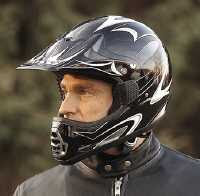More and more these days, riders of all terrain vehicles (ATVs) are becoming injured or even killed when their ATV wrecks, enforcing the need for safe operating procedures. This is especially important for teenagers who are interested in riding ATVs and are less likely to practice safe conduct while operating the vehicles. Keep in mind that ATVs are just as dangerous as cars, motorcycles, trucks, or sport utility vehicles, so only operate them using the proper techniques and procedures. Many riders neglect the fact that these vehicles have the capability to extremely injure or kill the drivers, but in the correct hands, ATVs can be a fun way to spend time in the great outdoors. Follow these ten safety tips when riding any ATV:
1.) Only drivers over the age of 16 should operate an ATV.
The American Academy of Pediatrics strongly recommends that children under the age of 16 should not operate an ATV. This is especially important, since younger children are usually injured on ATVs due to their size or inexperience with operating vehicles. Even once a child is 16 and able to operate an ATV, adult supervision should be present at all times.
2.) Always wear protective gear.
Just like operating a motorcycle or bike, riding an ATV requires you use proper protective gear. ALWAYS wear a helmet. Most serious or fatal accidents occur when the rider is not wearing a helmet and falls on his or her head. Helmets may not be the most stylish accessory, but they can literally save your life. Also, since most riders operate ATVs in wooded environments, be sure to wear proper eye protection, as a rock, branch, or even a bug can fly into your eye and cause damage. Furthermore, be sure to wear boots and gloves to protect your hands and feet while operating the ATV.
3.) Take a driver’s safety course.
Before you drive a car, you take a safety course, so why should driving an ATV be any different? Safety courses educate riders of the correct way to operate and ride an ATV to ensure he or she knows how to handle the vehicle. Also, safety courses will teach riders of all ages the appropriate behavior when riding an ATV, making it critical for teens and adults to attend.
4.) Only one rider per vehicle.
ATVs are designed for only one rider at a time. Since you have to manipulate your weight in order to control the vehicle, two riders on a vehicle is incredibly dangerous. Also, the ATV may be unable to successfully hold the combined weight of two riders, making it less stable and more apt to roll over. Finally, having an additional rider can distract the driver from the task of properly operating the vehicle.
5.) Ride ATVs in appropriate settings.
When it comes to where to ride your ATV, ensure you choose a proper setting. Avoid roads and streets, since ATVs are not designed nor intended to be driven on concrete or asphalt with larger cars and trucks. Also, avoid improper terrain that may encourage the ATV to roll over due to instability in the ground.
6.) Do not speed.
ATVs are designed to go a certain speed safely. Increasing the speed—especially through certain terrains—decreases your control and the vehicle’s stability, making you more prone to have an accident.
7.) Do not operate an ATV impaired.
Many adults find themselves tempted to operate an ATV while under the influence of drugs or alcohol. Even over the counter or prescription medications can impair your reaction time, thinking process, and judgment, so be sure to avoid operating an ATV during this time. Just like drinking and driving, alcohol and ATV driving does not mix.
8.) Carry a communication device with you at all times.
ATV operations should be sure to carry a cell phone or walkie talkie with them at all times so that they can call for help in the event of an emergency. This is especially true if you are riding alone, which is not encouraged, so that someone will be able to find you if you become injured. Whenever you plan to ride your ATV, you should either have another individual with you or notify someone of where you are going and when you plan to return.
9.) Do not attempt tricks or stunts while riding an ATV.
The most injuries on ATVs occur when the vehicles are operated improperly. Take great care in riding your ATV and be sure to avoid any tricks or stunts that will encourage an accident. Furthermore, avoid improper interaction with other individuals, whether they are on an ATV or not.
10.) Use common sense.
This final safety tip is by far the best. Your common sense can carry you a long way, especially involving your safety.
http://boxesandarrows.com/person/124746-mimae1981
Subscribe to:
Post Comments (Atom)

No comments:
Post a Comment